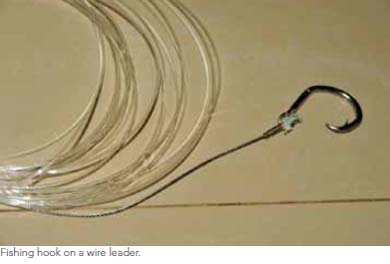Banning Wire Leaders: A Practical Solution for Reducing Shark Bycatch in Pelagic Longlines
 Longlines are used to target and catch swordfish, tuna and other valuable fish. But they also catch many other species, including sharks, which are often thrown back in the water dead or dying. Longline fishing is one of the world's most widespread fishing activities, with monofilament lines that can extend up to 40 miles and are baited with thousands of hooks. Even when sharks are not the target of a fishery, their catch can be substantial and can even make up more than the total catch of the targeted species. The fishing of sharks is often unregulated and unreported, especially at the species level. As a result, the bycatch of sharks in these fisheries is considered one of the most significant problems to the management of sharks globally. It is vital that mitigation measures be adopted to reduce the bycatch of sharks particularly in longline fisheries.
Longlines are used to target and catch swordfish, tuna and other valuable fish. But they also catch many other species, including sharks, which are often thrown back in the water dead or dying. Longline fishing is one of the world's most widespread fishing activities, with monofilament lines that can extend up to 40 miles and are baited with thousands of hooks. Even when sharks are not the target of a fishery, their catch can be substantial and can even make up more than the total catch of the targeted species. The fishing of sharks is often unregulated and unreported, especially at the species level. As a result, the bycatch of sharks in these fisheries is considered one of the most significant problems to the management of sharks globally. It is vital that mitigation measures be adopted to reduce the bycatch of sharks particularly in longline fisheries.
Why are monofilament nylon leaders better for sharks?
Many longline vessels use a wire leader (also known as a “steel trace”) to secure their catch on the line, but scientific studies have been conducted that show a nylon monofilament leader is actually a better gear option for reducing bycatch and increasing the targeted catch. The catch rate of sharks is higher on wire leaders than on nylon leaders. When caught on a wire leader, sharks can remain hooked for hours until the longline is hauled back on the boat. When the longline is retrieved, the sharks are often body gaffed or have the hook ripped out, both of which cause stress and increase mortality. When caught on the nylon monofilament leader, sharks are able to use their sharp teeth to bite through the material and escape. Escapees on nylon leaders are expected to suffer less injury and stress than sharks caught on wire leaders. As a result, the use of the nylon leader decreases bycatch of shark in the longline fishery and may increase the survival of the sharks that are able to escape.
Why are nylon monofilament leaders better for fishermen?
Many fishermen targeting tuna and swordfish prefer using nylon monofilament leaders, which increases the diversity of species caught and improves the catch of some target species. Fishermen believe the use of wire leaders can actually decrease target species catch, depending on the target species. Nylon leaders improve the natural looking movement of bait, which is important to tuna, and some fishermen believe tuna are able to see and avoid wire leaders. Tuna have smaller teeth and are less likely to bite through the nylon leader. Thus, catch rates for some targeted tuna catch is higher on nylon leaders. Catch of swordfish has been found to be higher on nylon monofilament as well. As a result, many fishermen use wire leaders only when wishing to maximize shark retention, creating a de facto shark fishery.
Although more gear is lost (bitten off of branchlines) when nylon leaders are used, interviews conducted with fishermen reveal that they generally do not consider this to be a large problem. In fact, as a safety measure and to save time, many fishermen will cut the leaders near the sharks, losing hooks in the process. Fishermen have noted the gear damage and loss through the escape of sharks is outweighed by the financial benefits from the increased catch of species, such as bigeye tuna (Thunnus obesus). In Australia, it was calculated that overall returns outweighed the cost of using nylon leaders and financial benefit was about US$8,000 per year. Thus, fishermen have found it economically beneficial to use nylon leaders instead of wire leaders.
Conclusion
It is clear that a ban on wire leaders will reduce shark mortality in fisheries where a large proportion of sharks caught as bycatch are killed either for retention or when discarded. A number of countries, including Australia, Ecuador, Federated States of Micronesia, New Caledonia, Papua New Guinea, South Africa, Tonga and Republic of the Marshall Islands, have already prohibited the use of wire leaders in their longline fisheries and other countries are currently considering enacting this policy. In addition to reducing shark bycatch, there are several other advantages to banning wire leaders including: immediate implementation, easy enforceability, minimal cost and increased catch of some target species.
Prohibit the use of wire leaders:
- Shark bycatch in tuna and swordfish fisheries is detrimental to the continued survival of many shark populations.
- Shark bycatch is higher on longlines that use a wire leader. Thus, the use of wire leaders creates a de facto shark fishery.
- The use of monofilament actually increases the catch of some target species of tuna and swordfish.
To view citations, download the PDF from the button at the top of the page.











